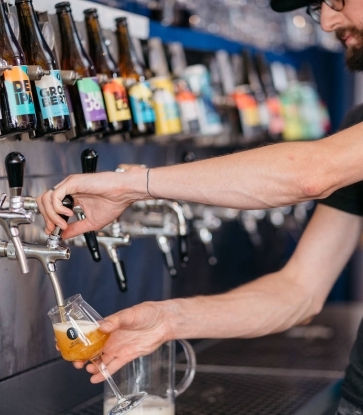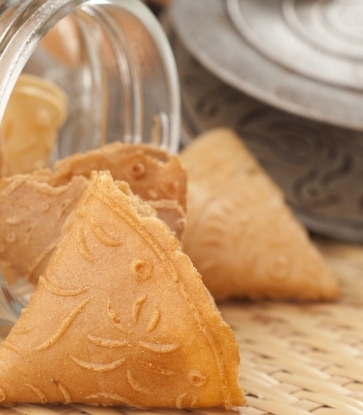For fervent chocolate lovers, a trip to Belgium could be the pilgrimage of a lifetime. However, if you had asked any foreigner to name three things related to the Low Country just about half a century ago, chances are chocolate would not have come up at all.
Cacao — in the form of hot chocolate — had been a luxury and exclusive treat for the social elites over the first four centuries since it was introduced to Europe from Mesoamerica. It wasn’t until the early 20th century that solid, industrialised chocolate products reached the masses. From that point on, Belgium began to find its footing in the cacao world. In 1912, Jean Neuhaus II invented praline, with stuffed fillings (like marzipan, used traditionally in all kinds of confections throughout Europe) inside a chocolate shell, while his wife Louise designed the dainty “ballotin box” for packaging three years later. The culture of enjoying chocolate as something pretty and gift-worthy began to spread.
The Iconic Seashell Makes Way For Adventurous Flavours
Belgian chocolate made itself known among the global audience through a charm offensive initiated by the 1958 Brussels World Expo. In the same year, Guylian was established, producing the famed seashell chocolate which will go on to become one of the icons of the country.
Thus began Belgium’s cacao-flavoured dominance. It made its authority known to the world through the slew of overseas branches set up by high-end Belgian chocolate labels within the last four decades, and Callebaut, the world’s leading supplier of couverture chocolate for pastry chefs and chocolatiers.
However, small Belgian chocolate producers — which make up 90% of the total number of chocolate companies, many of which have five or less employees — have something else to say. Having been exposed to the recent trends in the culinary industry, they try to adopt a more overarching view and integrate chocolate into the wider network of gastronomy, offering cacao lovers a more cutting-edge tasting experience and a more intimate relationship with the raw materials.

Dominique Persoone of The Chocolate Line is certainly the poster boy of this movement. Before finding his true calling in cacao, he worked in the kitchen of a MICHELIN-starred restaurant in Paris. The experience of dealing with a wide range of ingredients and advanced cooking techniques gave him an unconventional perspective on chocolate making.
“One of the first chocolates that I made was with wasabi. Now you see it (in many places) but 26 years ago, no one did it,” he says. “In the beginning, they were laughing at me, ‘Making chocolate with oysters and grass. He’s complete wacko’. But at the end, one of my mentors, Ferran Adria from El Bulli, said, ‘Dominique, you have to be honest with yourself. If your flavour is good, it’s good’. So I made chocolate with asparagus, chocolate with cauliflower…”
Persoone started his cacao adventure when the industry was still controlled by the big players. Many small, independent brands had yet to come into existence. Corresponding to the fact that most chocolatiers share the same source materials, the variety of products available to consumers was limited, as is the case with most large-scale productions.
But times have changed. Now a regular on Belgian TV shows, Persoone never shies away from showing he is having fun in doing things that would have been deemed out of bounds in the 1990s. While urging us to taste one of the bestsellers of his shop — chocolate served with a small plastic tube filled with tequila — the chocolate maker recalled an episode in which he went all out.
“I organised the birthday party for the Rolling Stones in 2007 and I made a machine for ‘sniffing’ chocolate. So I made a dessert for them. It was with different structures of raspberry with sorbet and caramel. Instead of putting chocolate in the dish, I made the machine for fun. With two spoons, you go ‘puff’: the chocolate goes into your brain and then you eat the dessert. It comes with chocolate flavour but you don’t [actually] eat it.”

“In the past we didn’t have as many ingredients as we have now. Traditionally, chocolate comes with marzipan… and you have the seashell which is a speciality of a Belgian brand,” Verleye says.
“Now we have many specialty ingredients that didn’t exist. I like to work with chefs. We combine passionate fruit with basil. We do caramel with sea salt. We do raspberry with rose. You see more and more colleagues do the same to combine the tastes. Not only do we have one taste in one chocolate. We have different layers.”
READ ALSO: How to Taste Chocolate Like a Pro

With overseas expansion, Belgian chocolatiers now have access to produce from different continents. The heightened awareness of the wider culinary world has put many local chocolate producers on a reverse route to import ingredients from abroad. New flavours aside, this helps them strike up a dialogue with gastronomic cultures from other parts of the world. This is where the country’s long-standing chocolate making foundation comes in. Arduous training enables the local chocolatiers to harness the exotic ingredients and incorporate them into products that consumers can really appreciate.
“Here in Brugges, you have more than 60 chocolate shops. That’s a lot. The thing is, in Belgium, we have really a lot of chocolate schools,” Persoone says.
For Verleye, using natural ingredients from across the globe means he has to account for and reconcile a large number of factors. For instance, the butter produced in summer, when the cows graze outside, would taste noticeably different from the batch made in winter by cows deprived of fresh grass. As cutting-edge and delicious as his flavour pairings are on paper, it is definitely not a straightforward process to ensure they deliver in reality. He cites the one of the techniques that takes his chocolates up a notch.
“We can make the fillings with the vacuum technique so there’s no air bubbles inside. You have more flavour instead. You cook a jam traditionally over a fireplace but now, we use steam. The colour is completely different and the taste is more intense,” he says.
“We listen to the people about what they want and then we try it out. It would take usually one to two weeks. Then we do it at a lab to see if the level of moisture is at the right position. It’s important to make sure the taste of the filling stays the same. You have two days to make all the fillings and, two months later, it must be of the same taste.”

Besides the attention towards the pairing of ingredients, Belgian chocolate makers surely have not forgotten about the chocolate itself. Many chocolatiers in the countries have tapped into the bean-to-bar concept, which sees them skipping the middlemen and sourcing beans directly from cacao farmers. Founded in Brussels, Pierre Marcolini began exploring the potential of the movement as early as 1995. Over the last decade, a new generation of Belgian bean-to-bar craftsmen entered the business, asking questions that their peers had never asked before. They wanted to know how to express the distinctive characteristics of the cacao beans from each (micro-)region. They tried to give a voice to the small cacao bean producers who had been getting the short end of the stick in the business. And they wanted to find out if the final product was any different when the independent chocolate labels have a say in every stage of chocolate making.
The Chocolate Line is at the forefront of it all. In its Brugges boutique (pictured in header), bags of raw cacao beans from various origins sit in the roasting room, waiting for the magical transformation. The room is separated from the public by just a glass panel, on which details of the batch being processed — the fermentation time, roasting temperature, the name of the farm and the farmer — are revealed. Persoone went a step further seven years ago, starting a cacao plantation of his own in Yucatán, Mexico.
READ ALSO: Ruby Is The New Brown In The Chocolate World

The Belgian new wave in chocolate making is not going to stop anytime soon. As Verleye is busy sourcing the right type of miso to fill his chocolate shells, Persoone is reviewing some of the fundamental ingredients in his chocolate in order to create healthier treats.
“I believe my challenge is to make chocolate more healthy. We use different sugars. One of the sugars we use a lot is coconut blossom sugar. I’m a beekeeper too. Last summer, we had 580kg of honey. I’m working with scientists to take the humidity out of honey to make a powder. Honey is very healthy and so is cacao. On the other hand, we have a lot of people who are allergic to something, definitely also with cow milk. So I changed the milk and I’m very happy with it. We did a test with coconut milk. It’s amazing.”


















